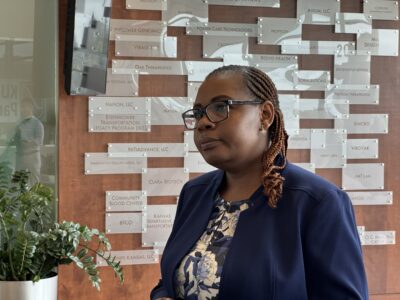KU herpetologist working to recover lost specimens

Rafe Brown, curator of herpetology at the Natural History Museum, holds the holotype of Myersophis alpestris, which is the first collected specimen of an adult snake Edward Taylor found in the Philippines in the 1920s. The specimen was lost in the 1960s. Thirty years later, the specimen was found in a group that had been on top of Taylor's desk and it is now back in KU's collection.

Frog specimen float in ethanol-filled jars ready to be identified and cataloged at KU's Natural History Museum.

Edward Taylor is pictured in this 1912 photo, taken while he was working in the Philippines.

Edward Taylor handles a caecilian specimen, which is a type of amphibian. Taylor was a herpetologist and an emeritus professor of zoology at Kansas University who Rafe Brown calls the father of Philippine herpetology.
A jar with a red ribbon around it sits on a shelf inside the Natural History Museum. Inside is one of the 330,000 amphibian and reptile specimens housed in the building, but this one is special.
It’s the holotype of Myersophis alpestris, the very first of a species of snake that Kansas University herpetologist Edward Taylor collected in the 1920s.
Specimens like this are part of the reason Rafe Brown, 42, curator of herpetology at the Biodiversity Institute at KU, has traveled to the Philippines 15 times in the last three years.
Brown, whose field of herpetology centers on amphibians and reptiles, returned last week from a trip to the island nation with more than 400 new specimens in tow.
The trip was covered under a grant of nearly $1 million from the National Science Foundation. The goal of the researchers working under the grant, which includes KU ornithologists, mammologists and Filipino researchers, is to document as many species as possible on the island, and their parasites.
Following in footsteps
Brown has another goal, though. He wants to find specimens that Taylor collected in the 1920s and 1930s that were destroyed during a World War II bombing and haven’t been collected since.
“Much of the work we’ve been doing has been going back, trying to visit the exact same locations where he was and trying to catch those animals,” Brown said. “There are lots of species that exist in literature but there are no specimens in any museum anywhere because they were blown up.”
The Biodiversity Institute keeps Taylor’s books in its herpetology library, which includes countless volumes filled with his personal notes. Through these notes, Brown, his co-workers and students piece together locations to visit to find what he calls “lost species.”
“We literally are following in his footsteps. We read his publications really carefully and try to get any hint we can of exactly where he went,” he said. “So we go back to the exact same place, try to find Taylor’s collection site, take his original paper and compare it to the things we catch in the field and see if we can catch a lost species.”
Brown said he and his team have about eight species in the lost collection to find, but they’re in much more remote areas. He knows the importance of finding them, though, to complete Taylor’s work.
“We think of him as the father of Philippine herpetology, because he described and discovered more species of amphibians and reptiles from the Philippines than anyone else in the world,” Brown said.
Back to the Philippines
Brown said the grant extends a few more years, so he’ll return to the island nation up to 12 more times.
He and his team have made quite a bit of progress so far, naming about 60 new species with at least that many more to name. Often they can’t tell if an animal is a new species until they analyze its DNA, but sometimes it just clicks when they’re in the field that they’ve found something new.
“That moment of discovery is really exciting. We definitely live for that stuff,” he said.
During the last trip, Brown came home with tubs of relatively common species, but the animals were rare finds in collections because the government restricted the area where they lived for years.
“They’re not considered threatened in any way but they’re just rare in collections and biologists know very little about them,” he said.
One such species, a brown snake, had only been collected as females. Brown found a male specimen this trip.
Brown knows he’ll return many times to the Philippines, and his next big trip will be a two-month research expedition with about 25 people in the field this summer. The goal is to diversify their already growing collection.
“We’ve had to try really hard not to spend too much time in one place,” he said.







